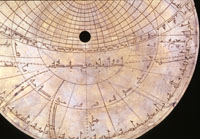Religious calculations with the astrolabe
The earliest determinations of the qibla (the direction in which to face when praying) were associated with the rising and setting of the sun and fixed stars. This meant that the
astrolabe was ideally suited to qibla calculations because these calculations are all simple and quick using the rete. Since mosques are also aligned according to the qibla, there is some evidence that astronomical calculations were made to determine their siting and orientation. There were also mathematical methods for calculating the qibla which were used to generate the tables of qibla for different places that are often found in collections of astronomical tables. However, the formula for the qibla is extremely complicated, depending on
spherical trigonometry to determine positions on the celestial sphere, so the astronomical approximations taken with instruments were not abandoned. There is evidence of different values of the qibla being used within a single town, as different methods and approximations were used to calculate the direction in which to face the mosque. Astronomers were not always consulted during the building of mosques, however, since their alignment does not correspond with values of the qibla used locally.
Most Islamic astrolabes have on them a prayer line which indicates the times of the five daily prayers: sunset, nightfall, daybreak, midday and mid-afternoon (the Islamic day begins with the rising of the moon at sunset). Daylight prayers are defined in terms of shadows, and night prayers in terms of twilight states. They vary according to latitude, and all depend on the position of the sun. The astrolabe therefore lends itself well to measurement of the prayer times. Indeed, by the thirteenth century the muwaqqit, a professional astronomer employed by a mosque, was a widespread institution. The muwaqqit calculated prayer-times and also made instruments, gave lectures to students and wrote treatises on astronomical subjects. Astronomical tables for the prayer times had to be used in conjunction with an instrument to check when the time advocated in the tables had actually arrived, astrolabes and sundials being the most popular instruments for this. Interestingly, when the astrolabe began to be used and made in Western Europe, not all of them lost the prayer line because it was still useful as a shortcut to finding the times of sunrise and sunset, which are important for the timing of Christian prayers.
Recommended Reading
Sarah Schechener Genuth "Astrolabes: a Cross-Cultural and Social Perspective" introduction to Webster (ed)
Western Astrolabes
David King Astronomy in the Service of Islam 1993
John North, The Fontana History of Astronomy and Cosmology, London 1994
Full Bibliography
 The prayer line (the hatched line crossing the astrolabe) on an Islamic astrolabe in the Whipple Collection.
The prayer line (the hatched line crossing the astrolabe) on an Islamic astrolabe in the Whipple Collection.